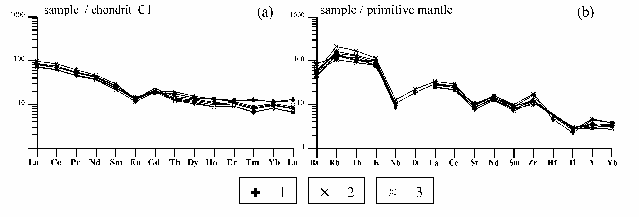|
BATOLITHS OF THE EASTERN FLANK OF THE MONGOLIAN-OKHOTSK OROGENIC BELT AND THEIR RELATION TO THE VOLCANISM OF THE REGION (THE KHARGA PLUTONIC COMPLEX) Derbeko I.M.*, Agafonenko S.G.** *Institute of Geology and Nature Management FEB RAS, Blagoveschensk, Russia, derbeko@mail.ru **VSC «Amurgeologia», Blagoveschensk, Russia, agafonenko@amurgeo.ru
The eastern branch of the Mongolian-Okhotsk orogenic belt, being actually amagmatic in end of the Jurassic, experienced an intensive volcano-plutonic activity at its marginal eastern flank in the beginning of the Cretaceous. Vast fields of volcanics and comagmatic plutonic bodies began to form there corresponding to three age intervals: the end of the late Jurassic – 120 Ma, 105 – 100 Ma and 95-90 Ma (Sorokin et al., 2006; Derbeko et al., 2008a; Derbeko et al., 2008b). At a background of a common a magmatism of the area the Kharga plutonic complex forming the batholith of the same name, which was distinguished in 1942 by N.A. Rakov, occupies a special position. Age of the rocks of the above complex has been changing from the Late Paleozoic to the Late Cretaceous (Martynyuk et al., 1990), 40 intrusive bodies were thought to belong to it. The Kharga Batholith is a petrotypical massif of the complex (Martynyuk et al., 1990) having a rhomboid shape with the smooth angles (27x17 km2). It is composed of granodiorites, quartz diorites, granites with a gradual transition established between them. The main represent tatives are granodiorites, medium – grained, sometimes porphyry – like rocks with hypidiomorphic grained texture. Their composition is as follows: andesine An35-42 (30-45%), anorthoclase (10-30%), quartz (10-25%), biotite (5-10%), hornblende (3-7%). In quartz-diorites the quartz content decreases to 10%, the anortoclase content – to 5%, while that of plagioclase increases up to 60%. In orthoclase the microperthite ingrowths of albite are marked. Sometimes quartz forms poikilitic ingrowths in anorthoclase and plagioclase, being contained in granites in approximately equal amounts at invariable presence of the rest of the ore – forming minerals. The accessory minerals are: apatite, sphene, zircon, magnetite, orthite, rarely – garnet. Cataclasm and a weak gneissousness are characteristic of the rocks of the complex in question. According to geological data the timing of the rocks formation of the complex is constrained by their intrusion of the Lower Jurasic sediments and by the intrusion of those ropcks ry the bodies of the late Cretaceous rock complex. Their age according to Rb-Sr isochrone is 98±4 Ma (Agaphonenko, 2002). All the varieties of the complex are the rocks of a normal series (Na2O+K2O=5.6-7.5 mas.%) at relatively close concentrations of Na2O and K2O, high potassic of calcareous – calc-alcali series (Frost, 2005), magnesium, low titanium. REE diagrams (Fig. 1a) age characterized by weakly expressed negative Eu anomaly: (Eu/Eu*)n=0.6; by equal predomination of standardized LREE contents over intermediate contents – (La/Sm)n=3.2 and the intermediate contents over HREE amounts – (Gd/Lu)n=3.1. (La/Yb) n ratio is 7.4, which is indicative of the moderate differentiation of Lanthanoids. Concentrations of high – charged elements are low: Nb (7-10 ppm), Ta (0.76 ppm), Hf (1.39 ppm), Zr (105-181 ppm). The concentrations of Ti (2925 ppm), Sr (101-201 ppm), Y (19-25 ppm), Yb (1.8-2.1 ppm) (Fig. 1b) and transition elements (Ni – 12-18, Co – 6-13, Cr – 40-150, V – 26-64 ppm) are also low.
Regarding the concentrations of petrogenic and microelements the Kharga complex granitoids may by compared with volcanic and occurrences of Selitkan volcanic structure (Fig. 1).Main characteristics of granodiorites of the Kharga complex (x3173 - 98±4 Ma, Rb-Sr) and that of the Selitkan volcano-plutonic zone (s3207-1 - 105±2 Ma, U-Pb) are given in the Table.
Table. Composition of granodiorites of Khingan batolit and Selitkan zone
According to the obtained data the geochronological, petro and geochemical characteristics of the rocks of the Kharga batholites are rather comparable with that of the medium – basic rocks of the Selitkan zone. The absence of volcanics of this structure within the Kharga rock bodies’ development zone may be explanted by a deeper shear which is perhaps connected with a thrust of the Ul’ban terrane over that area and a widespread development of the overlaying rocks of the Late Cretaceous volcano-plutonic complex. Thus, one can assume that granitoids of the Kharga complex may belong to the plutonic composition of basic – medium composition of the Selitkan volcano-plutonic zone.
References Agaphonenko S.G. Geological map of Russian Federation. Scale 1: 200 000 (Second edition). Tugur series. Page N -53-XXVI. Blagoveschensk. 2002. Martiniuk M.V., Ryamov S.А., Kondrateva V.А. The scheme correlation magmaitik complexes Khabarovsk region and Amur region. Khabarovsk: IGU "Dalgeologia". 1990. 215 p. Sorokin A.A., Sorokin A.P., Salnikova E.B., Derbeko I.M., Kotov A.B., Yakovleva S.Z. Geochronology of rhyolites of Unerikansky complex of Eastern flank of Umlecano-Ogodginsky belt // Isotopic dating of the forming process of ore, magmatizm, sedimentation and metamorphism. Material of the III-ed Russian conference about isotopic geochronology. July 6-8 2006. Moscow. Vol. 2. P. 311-314. Derbeko I.M., Sorokin A.A., Salnikova E.B. et al. Age of Felsic Volcanism in the Selitkan Zone of the Khingan–Okhotsk Volcanoplutonic Belt, Russian Far East // Doklady Earth Sciences, 2008a, Vol. 418, N 1, pp. 28–31. Derbeko I.M., Sorokin A.A., Ponomarchuk V.A. et al. First Geochronological Data on Felsic Lavas from the Ezop–Yamalin Volcanoplutonic Zone, Khingan–Okhotsk Volcanogenic Belt. // Doklady Earth Sciences, 2008b, Vol. 419, N 2, pp. 231–234. |
